 Tony Jolliffe/BBC
Tony Jolliffe/BBCAfter lying hidden under meters of volcanic rock and ash for 2,000 years, a “once in a century” find has been discovered in the ancient Roman city of Pompeii.
Archaeologists discovered a sumptuous private bath house – potentially the largest ever found there – with warm, hot and cold rooms, exquisite artwork and a huge swimming pool.
The spa complex lies at the heart of a magnificent residence that was uncovered during major excavations over the past two years.
“It’s these spaces that are really part of the ‘Pompeii effect’—it’s almost as if people just left a minute ago,” says Dr. Gabriel Zuchtriegel, Director of the Archaeological Park of Pompeii, who exclusively revealed the new find. BBC News.
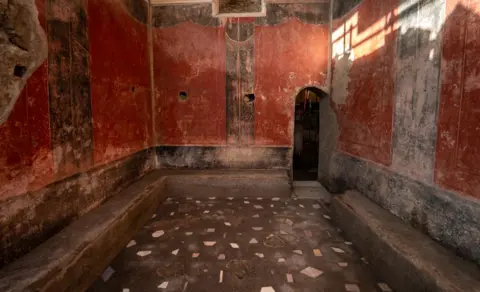 Tony Jolliffe/BBC
Tony Jolliffe/BBC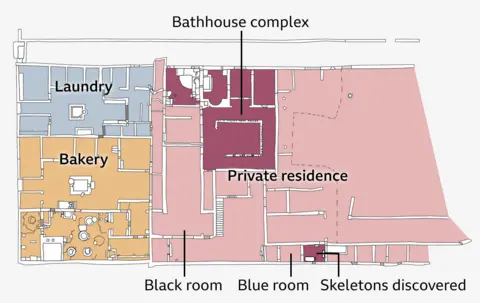
Analysis of two skeletons discovered in the house also shows the horror Pompeii’s residents faced when Mount Vesuvius erupted in AD 79.
The bodies belonged to a woman between the ages of 35 and 50, who was clutching jewelery and coins, and a younger man aged between 20 and 20.
They barricaded themselves in a small room but were killed when a tsunami of superheated volcanic gas and ash – known as a pyroclastic flow – tore through the city.
“It’s a dramatic place and everything you find here tells you about the drama,” says Pompeii curator Dr. Ludovica Alesse.
A third of the ancient city still lies hidden under volcanic debris after the disaster, but new excavations – the most extensive in a generation – are providing new insights into ancient Roman life.
The archeology was followed by a documentary team from the BBC and Lion TV for a series entitled Pompeii: New Excavation.

An entire block of Pompeii has now been uncovered, revealing a laundry and bakery, as well as a large private house. They are all believed to have been owned by one wealthy individual, possibly Aulus Rustius Verus, an influential Pompeian politician.
The discovery of the spa house is another confirmation of its elite status, says Dr. Zootriegel.
“There are only a few houses that have a private spa complex, so it was really something for the richest of the richest,” he says. “And this is so huge—it’s probably the largest spa complex in a Pompeian private home.
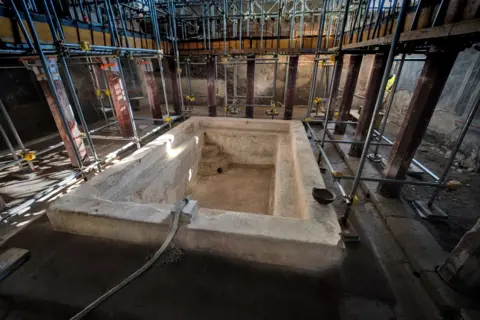 Tony Jolliffe/BBC
Tony Jolliffe/BBCThose lucky enough to have access to the bathroom suite would undress in a cloakroom with bright red walls and a mosaic floor dotted with geometric patterns inlaid with marble from across the Roman Empire.
They then headed to the hot room, bathed in the tub and enjoyed the sauna-like heat provided by the suspended floor that allowed the hot air to flow underneath and the cavity walls where the heat could circulate.
They then moved into a brightly painted warm room where the oil was rubbed into the skin before being scraped off with a curved tool called a strigil.
Finally they entered the biggest and most amazing room of all – the refrigerator or cold room. Surrounded by red columns and frescoes of athletes, the visitor could cool off in the plunge pool, which is so large that it can fit 20-30 people.
“In hot summers, you could sit with your feet in the water, chat with friends, maybe enjoy a glass of wine,” says Dr. Zuchtriegel.


The spa house is the latest find of this extraordinary house.
A huge banquet room with jet black walls and stunning artwork of classical scenes was found last year. A smaller, more intimate room – painted pale blue – was also discovered where the residents of the house went to pray to the gods.
The residence underwent a medium renovation – tools and building materials were found throughout. In the blue room, a pile of oyster shells lie on the floor, ready to be ground up and applied to the walls to give them an iridescent sheen.
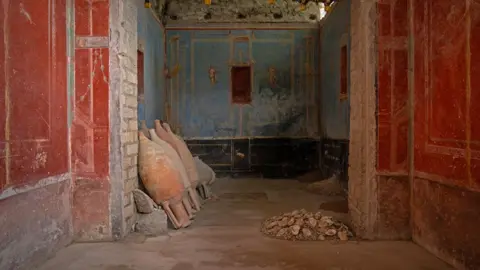 Tony Jolliffe/BBC
Tony Jolliffe/BBCNext to this beautiful space, in a cramped room with almost no decoration, a stark discovery was made – the remains of two Pompeians who did not manage to escape the eruption.
The skeleton of a woman was found lying on a bed, curled up in a fetal position. In the corner of this small room was the body of a man.
“The pyroclastic flow from Mount Vesuvius came down the street just outside this room and caused the wall to collapse, essentially crushing him to death,” explains Dr. Sophie Hay, an archaeologist at Pompeii.
“The woman was still alive when he was dying – imagine the trauma – and then this room filled with the rest of the pyroclastic flow and she died.
Analysis of the man’s skeleton showed that, despite his young age, his bones showed signs of wear and tear, suggesting that he was of a lower status, perhaps even a slave.
The woman was older, but her bones and teeth were fine.
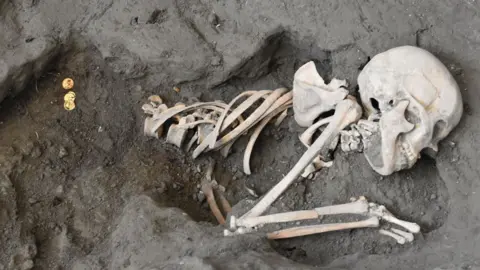 Pompeii Archaeological Park/Sophie Hay
Pompeii Archaeological Park/Sophie Hay“She was probably someone higher up in society,” says Dr. Hey. “It could have been the wife of the owner of the house – or maybe an assistant looking after the wife, we just don’t know.
An assortment of objects – glass, bronze jugs and pottery – were found on a marble table top in the room – possibly brought into the room where the pair had positioned themselves in the hope of waiting out the eruption.
But it is the objects clutched by the victims that are of particular interest. The younger man was holding some keys while the older woman was found with gold and silver coins and jewelry.
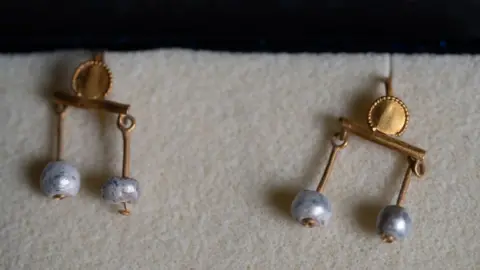 Tony Jolliffe/BBC
Tony Jolliffe/BBCThese are stored in the Pompeian Vault along with other priceless finds of the city and we had the opportunity to see them with archaeologist Dr. By Alessandro Russo.
The gold coins still shine like new, and he shows us delicate gold and natural pearl earrings, necklace pendants and intricately etched semi-precious stones.
“When we find this kind of object, the distance between antiquity and modern times disappears,” says Dr. Russo, “and we can touch a little piece of the lives of these people who died in the eruption.”
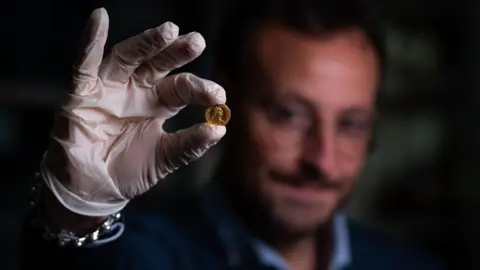 Tony Jolliffe/BBC
Tony Jolliffe/BBC
Dr Sophie Hay describes the private spa complex as a once-in-a-century discovery that also sheds more light on the darker side of Roman life.
Just behind the warm room is the boiler room. Pipes brought water from the street – some was pumped into a cold plunge pool – and the rest was heated in a lead boiler designed for a warm room. The valves that regulated the flow look so modern that you could turn them on and off today.
With the furnace sitting below it, the conditions in this room would have been unbearably hot for the slaves who had to keep the entire system running.
 Tony Jolliffe/BBC
Tony Jolliffe/BBC“The most powerful thing about these excavations is the stark contrast between the lives of slaves and the very, very rich,” says Dr Sophie Hay.
“The difference between a life of luxury in a spa compared to a furnace where slaves would feed the fire and toil all day.
“A wall is all that could separate you between two different worlds.
The excavation is in its final weeks – but new discoveries are still emerging from the ashes. A limited number of visitors are allowed to visit the dig while it is underway, but it will eventually be fully open to the public.
“Every day there is a surprise,” says Dr. Anna Onesti, director of the excavations.
“Sometimes I come to work in the morning thinking it’s a normal day at work – and then I find out we’ve found something special.
“It is a magical moment in the life of Pompeii and these excavations offer us the opportunity to share it with the public.”

